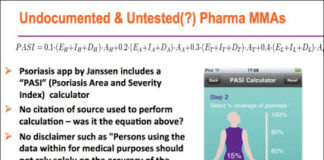The Federal Trade Commission (FTC) just released new guidelines to expand its decade-old rules on Web ads to the world of social media and smartphones, reports the Wall Street Journal (guidelines attached to this post).
“Short-form ads on Twitter and Facebook have the same basic requirement as any old-fashioned ad: They can’t mislead consumers, federal regulators said Tuesday. Whether it is including the average effectiveness of a weight-loss shake or noting that a celebrity was paid to push a product in a Twitter post, marketing company need to apply the same standards to online ads as they long have to older media, according to guidelines released Tuesday by the Federal Trade Commission.”
“That means making room for full disclosure even in a 140-character tweet on Twitter.” [my emphasis]
“If a company can’t find a way to make its disclosure fit the constraints of social or mobile ad, it needs to change the ad copy so that it doesn’t require a disclosure, the agency said, making that point explicit for the first time,” reports WSJ.
But Wait! The FTC also codified a version of the infamous “one-click rule” in its guidelines. Principle/guideline # 4 states:
“To make a disclosure clear and conspicuous, advertisers should:
- Place the disclosure as close as possible to the triggering claim.”
BUT…
- When a space-constrained ad requires a disclosure, incorporate the disclosure into the ad whenever possible. However, when it is not possible to make a disclosure in a space-constrained ad, it may, under some circumstances, be acceptable to make the disclosure clearly and conspicuously on the page to which the ad links.
That, my friends, is a version of the “one-click rule” that has haunted pharma marketers for years — a “rule” that wasn’t really sanctioned by the FDA, which also shot it down with those April 2009 warning letters (see Overcoming Space Limitations in Social Media
Bring Out the Old (“One-Click Rule”) and Ring in the New Ideas). Up until that point, pharma marketers believed they could create short branded ads — such as Google adwords and Tweets — that did not include the FDA-required important safety information (ISI) as long as that information was one click away (on the landing page summoned via a link within the ad).
Certain Circumstances
Yes, there are certain circumstance under which this “FTC One-Click Rule” applies. Namely:
“If a product or service promoted online is intended to be (or can be) purchased from ‘brick and mortar’ stores or from online retailers other than the advertiser itself, then any disclosure necessary to prevent deception or unfair injury should be presented in the ad itself — that is, before consumers head to a store or some other online retailer.”
What the FTC is saying is that it is OK to use its “one-click rule” if the product or service can only be purchased from the advertiser. Purchasing of Rx drugs is a special case in that pharmaceutical companies do not sell drugs directly to consumers. We have to go to “brick & mortar” agents of the drug industry — doctors and drug stores — to “purchase” the product. Surely, these “learned agents” are qualified — and even required by law — to educate consumers about the ISI associated with Rx drugs. Therefore, the above “circumstance” would not apply if this rule were applicable to pharma (i.e., if FDA adopted the rule as its own).
Of course, FTC advertising guidelines do not apply to Rx pharmaceutical products because of an agreement between FDA and FTC. FDA still has not come out with any guidelines for drug ads on social media such as Twitter and it may never do so (see FDA’s “Social Media Guidance Cliff”: An Open Letter to Megan Clark Velez).
But FTC’s guidelines may provide a hint as to how the FDA might craft its own guidelines should that every happen; not that the FDA is an FTC copy cat, mind you. But still, FTC’s release of these guidelines can be used to embarrass the FDA into action, which I hope is the result of this and other posts.
FOLLOW-UP: In a post made AFTER FDA published its social media guidelines, I clarify some issues, including the following: “Some circumstances” do NOT include disclosures of health and safety information: “Hyperlinks should not be used to communicate disclosures that are an integral part of a claim or inseparable from it, including important health and safety information,” says FTC. Please read “The ‘Risk-Only’ Landing Page Requirement: Can We Get FDA to Adopt FTC’s Thinking and Drop This Rule?“









![6 Digital Tools at the Center of Healthcare Digitalization [INFOGRAPHIC]](http://ec2-54-175-84-28.compute-1.amazonaws.com/pharma-mkting.com/wp-content/uploads/2021/04/6DigitalTools_600px-100x70.jpg)




